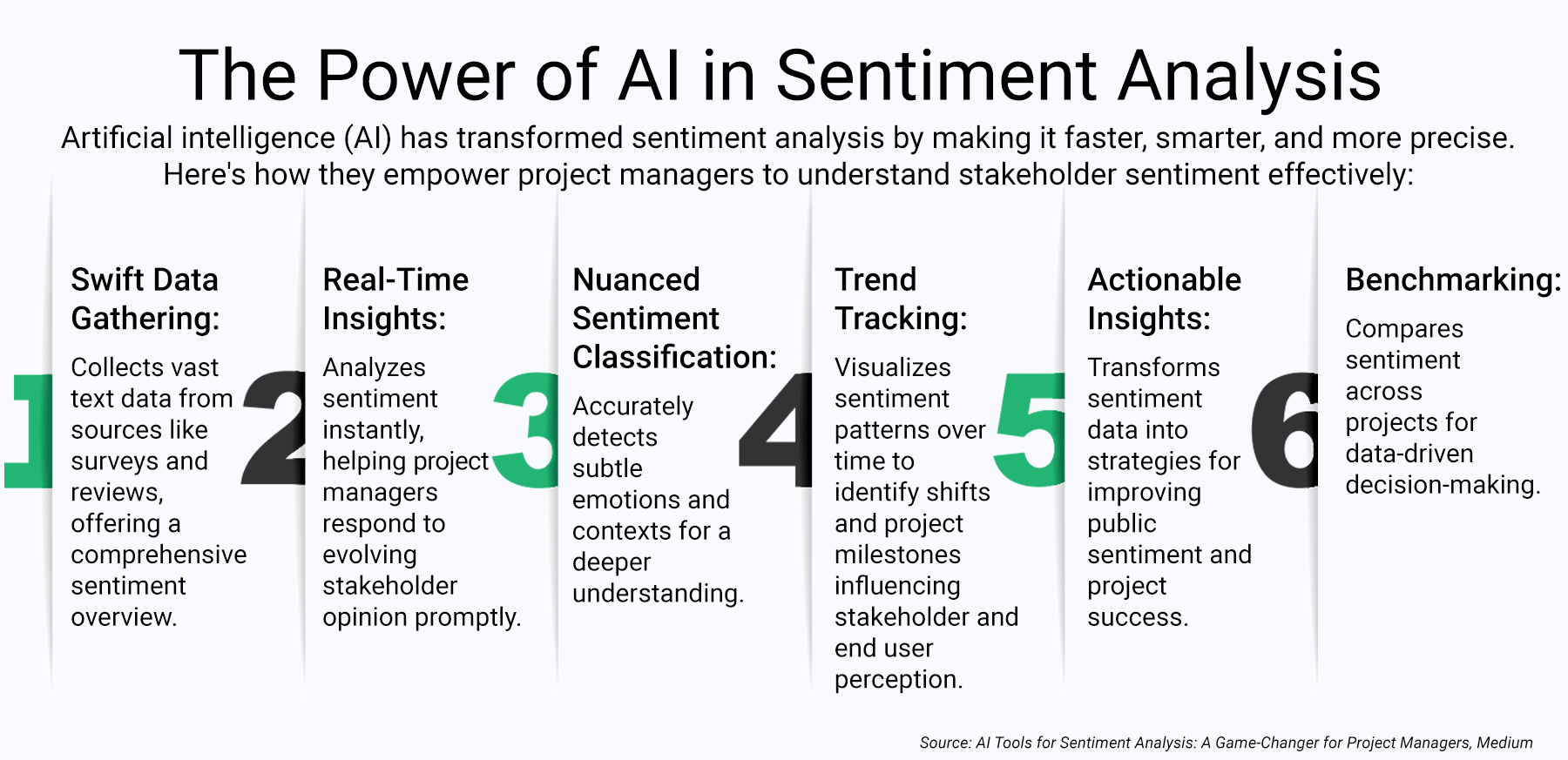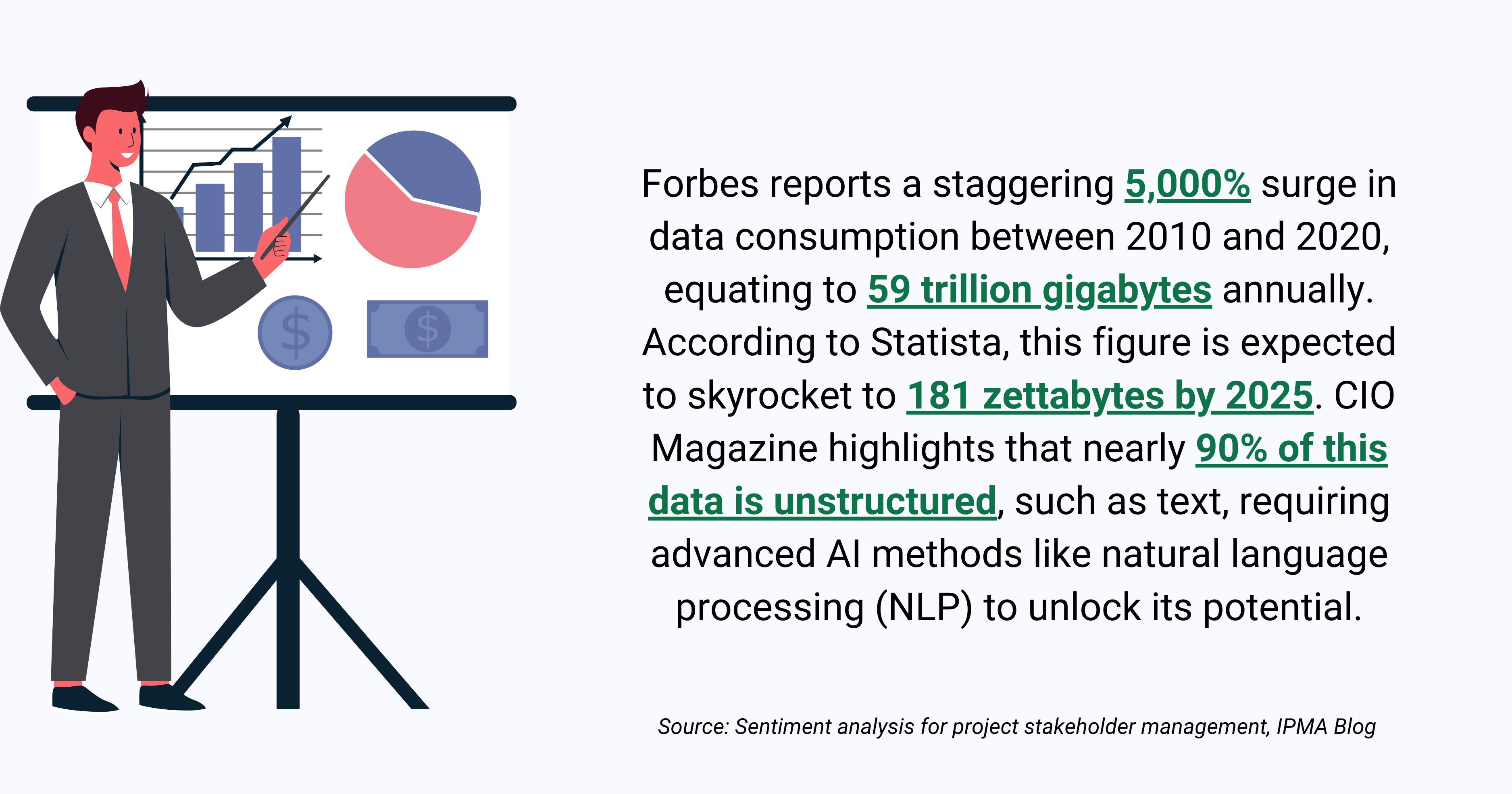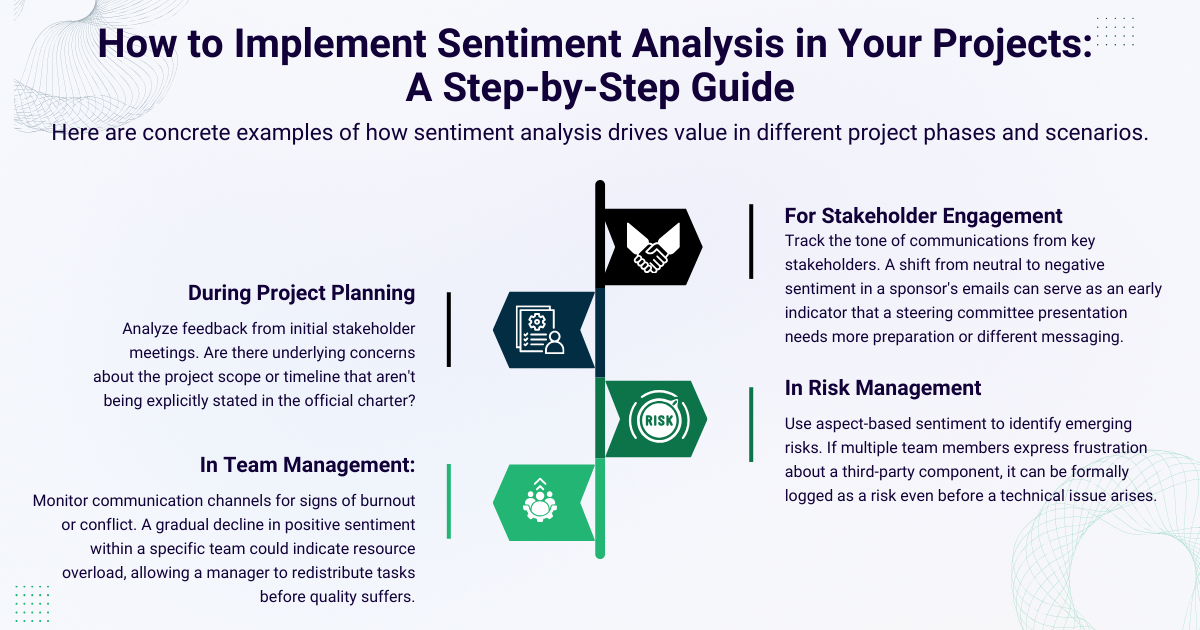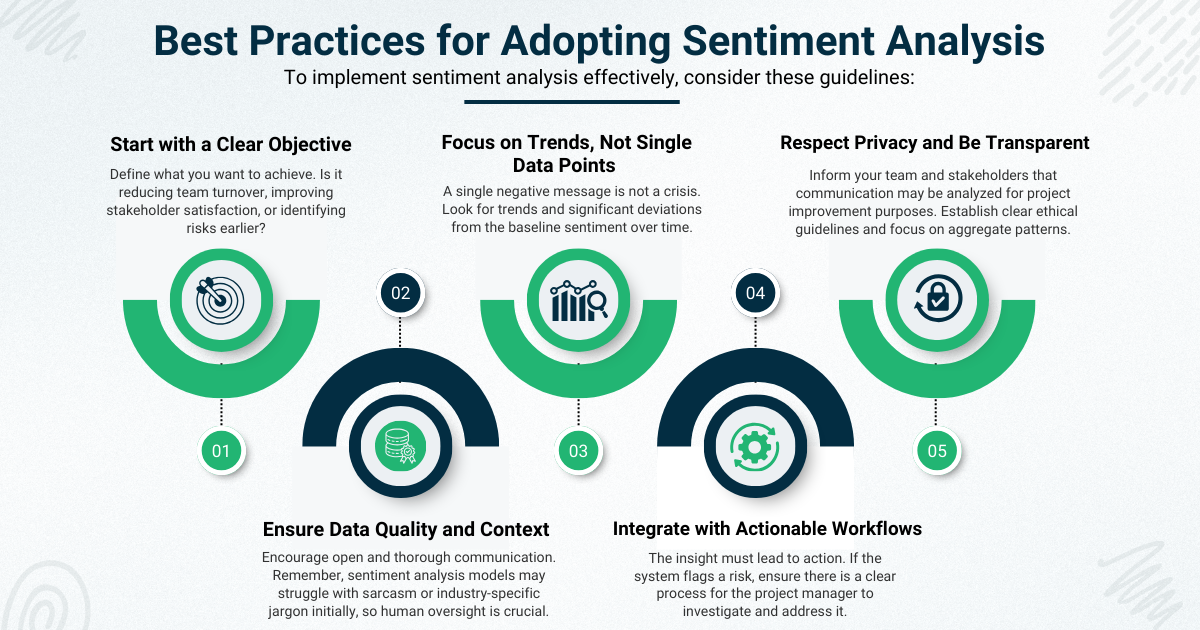
Quick Summary: Dashboards track budgets and schedules, but they miss the human signals that decide project success. Nearly half of failures stem from miscommunication and misaligned expectations—blind spots metrics can’t expose. Sentiment analysis changes that by decoding emotions in feedback, chats, and surveys, giving leaders an early-warning system for risks. Paired with predictive project management, it blends hard data with human perception to surface hidden issues, strengthen trust, and drive smarter, more resilient decisions.
Sentiment Analysis: Exposing Risks Dashboards Can’t Show
“What went wrong? The tasks were on track, the budget was within limits, and yet… the project collapsed.” If this sounds familiar, you’re not alone. According to the PMI’s Pulse of the Profession report, nearly half of all project failures can be traced back to poor communication and misaligned stakeholder expectations, issues that aren’t always visible in dashboards or spreadsheets. This is where sentiment analysis becomes a game-changer.
By systematically analyzing how stakeholders, sponsors, or team members feel about project progress, leadership decisions, or delivery timelines, organizations gain an early-warning system for risks that might otherwise remain hidden until it’s too late. A subtle change in tone in feedback, a rise in frustration in team chat logs, or neutral stakeholder surveys shifting toward negativity can signal issues far earlier than cost or schedule variances ever will.
Unlike traditional reporting, which looks backward at hard metrics, artificial intelligence-driven sentiment analysis or opinion mining offers real-time visibility into the human side of projects. When paired with a predictive project management solution, it allows leaders to combine objective indicators (schedule, resources, performance) with subjective insights (stakeholder mood, team morale). This fusion equips executives with a richer, more proactive understanding of project health, enabling timely interventions, stronger stakeholder trust, and more resilient project outcomes.
This article will explore how sentiment analysis works in the project environment, its methods and challenges, real-world applications, and how predictive intelligence transforms raw sentiment data into actionable foresight for project leaders. It will also highlight why organizations should consider leveraging it across different aspects of project operations.
What is Sentiment Analysis in Project Management?
Sentiment analysis is the process of interpreting text to identify the emotional tone—whether it’s positive, negative, or neutral. This can be a game-changer in project management when dealing with vast amounts of communication data, like emails, meeting notes, or feedback surveys. By leveraging sentiment analysis tools, you, the project leaders, can gain real-time insights into stakeholder feedback and team morale. These insights help identify potential concerns early, strengthen collaboration, and maintain a productive project environment.
Let’s explore why it’s a game-changer in keeping projects aligned and thriving.
Turn conversations into clarity. Discover how TrueProject transforms raw feedback into predictive insights that keep your projects on track. See the difference sentiment analysis can make—start learning here.

Why Sentiment Analysis in Project Management Matters in 2025?
Projects rarely fail because of missing functions or deadlines. Many derailments stem from misalignment in stakeholder expectations, conflicts, poor communication, or hidden dissatisfaction. Sentiment analysis brings the emotional and attitudinal layer into the picture, so you don’t just track metrics, but also perceptions.
How does your team feel about their roles? What’s their take on project communication? AI-powered sentiment solutions provide precise, data-driven feedback. Let’s dive into its key benefits:
- Unbiased Insights: Personal biases can cloud evaluations. AI eliminates this, offering objective insights. Why leave blind spots in your strategy when the predictive project management solution can give you the complete picture?
- Actionable Improvements: Can you pinpoint what’s dragging performance down? Sentiment analysis connects emotions to specific issues, helping teams prioritize meaningful fixes. For example, identifying frustration linked to interface slowdown ensures improvements where they matter most.
- Effortless Scaling: Manual analysis is impossible with vast amounts of unstructured data, emails, transcripts, and surveys. A predictive project management solution processes emotions at scale, giving every stakeholder a voice and fostering transparency and collaborative engagement.
- Real-Time Reactions: Quick responses can make or break a project. Sentiment analysis detects dissatisfaction early, enabling action before minor issues become significant risks. Alerts keep projects on track.
- Better Crisis Management and Change Leadership: Integrating emotional feedback with operational metrics reduces the likelihood of overlooking hidden risks, improving response strategies and communication in turbulent phases.
- Strategic Decision-Making: Layering sentiment insights with traditional project health data gives leaders a fuller view, enabling more informed decisions.
Sentiment analysis transforms feedback into a solution for smarter decisions and stronger outcomes. While these benefits are powerful, sentiment analysis proves even more transformative when applied to stakeholder management—the very foundation of project success.

How Sentiment Analysis Elevates Stakeholder Management
By transforming raw feedback into actionable insights, sentiment analysis strengthens every layer of project management. But its true potential shines in stakeholder engagement—where understanding emotions or feedback can make or break a project. Here’s how it makes a difference:
- Proactive Problem-Solving: Stakeholder concerns often surface in emails, meeting notes, or casual conversations. Sentiment analysis helps decode these signals, highlighting potential issues early. By monitoring feedback in real-time, teams can spot potential project issues and take immediate action. For larger projects with numerous stakeholders, this level of insight is invaluable. It allows project teams to organize focused discussions, address concerns directly, and realign expectations to maintain trust and progress.
- Strengthening Crisis Response: Crises test projects and stakeholder relationships. Sentiment analysis offers a lifeline, providing real-time insights into stakeholder reactions. A predictive project management solution ensures no risk goes unnoticed by blending emotional cues with system data, offering real-time insights to manage crises effectively. These insights help teams craft better response strategies, ensuring concerns are addressed effectively.
From preventing issues to navigating challenges, sentiment analysis equips project managers to engage stakeholders meaningfully and ensure that every voice is heard. It’s not just about managing emotions; it’s about building trust, refining strategies, and driving project success.
See stakeholder confidence in action. Experience how TrueProject turns unspoken concerns into predictive insights that strengthen trust, prevent crises, and drive success. Book your demo today.

Challenges of Sentiment Analysis in Project Management
While sentiment analysis brings powerful insights into the human side of projects, applying it effectively is not without hurdles. Leaders should be aware of these challenges to avoid misinterpretation and to ensure that the insights drive constructive action.
- Context Misinterpretation: Words carry different meanings depending on context. A stakeholder’s comment like “This sprint was a killer” could mean excellent performance or excessive workload. Sentiment algorithms often misread sarcasm, idioms, or cultural nuances, leading to misleading classifications.
- Domain-Specific Language: Project environments are filled with jargon — terms like “slippage,” “variance,” or “critical path” might not carry emotional weight in project reporting but could be flagged incorrectly by generic sentiment tools. Without domain adaptation, analysis may distort the real mood.
- Data Quality & Availability: The accuracy of sentiment analysis depends heavily on the volume and quality of textual data. Sparse or biased feedback (e.g., only vocal stakeholders responding) may not represent the broader sentiment, resulting in skewed insights.
- Ambiguity & Subjectivity: Even human annotators often disagree when labeling sentiment. What feels neutral to one reader may seem negative to another. This subjectivity translates into models, making absolute sentiment scores unreliable without proper calibration.
- Real-Time Processing Complexity: Projects often require near-real-time monitoring of team morale or stakeholder perception. Building pipelines that instantly clean, analyze, and visualize sentiment data is technically demanding and may strain resources without robust systems.
- Integration with Project Metrics: Sentiment alone provides a partial view. Its real power lies in integrating objective indicators like timelines, budgets, or resource utilization. Many organizations struggle to correlate these dimensions effectively, limiting the value of insights.
But with every advantage comes complexity, and sentiment analysis is no exception. Its power is only realized when you understand and overcome its challenges. Overcoming these obstacles isn’t the end; it’s the beginning of something far more powerful: predictive project management that fuses sentiment with system data for proactive control.

Predictive Project Management: Next-Level Sentiment Integration
Traditional tools focus on cost, scope, and schedule. A predictive project management solution goes far beyond by merging structured project metrics with subjective stakeholder and team sentiment in real time. It ingests data from your project management software (Jira or Asana), communication tools, and documents. The integrated sentiment analysis engine then processes this data continuously. The system doesn't just report that the team's sentiment is negative; it can correlate the negativity with a specific task consistently missing its deadlines, flagging it as a high-probability risk. This allows project leaders to allocate resources or adjust plans before the issue impacts the critical path. Further, this approach helps project leaders:
- Forecast emerging risks that pure performance metrics can’t detect.
- Spot morale drops early and mobilize support resources.
- Maintain project health by blending “hard” system data with “soft” emotional cues in dashboards and alerts.
- Make evidence-based decisions confidently, even in periods of change or crisis.
This evolution naturally leads to the next step, turning predictive insights into actionable strategies that directly shape how you engage with stakeholders and teams.
Don’t settle for reactive reporting. See how TrueProject integrates sentiment with hard project data to predict risks, protect morale, and keep your projects thriving. Discover the full introduction here.
The Conclusion
AI-powered sentiment analysis solutions have become an essential resource for project managers aiming to understand stakeholders' and teams’ perceptions of their projects. By transforming unstructured data into actionable emotional insights, you bridge the gap between numbers and human experiences, creating a foundation for meaningful engagement and precise decision-making. Are you ready to take the pulse of your projects in real-time? Imagine the impact of addressing concerns before they escalate or aligning your communication strategies to resonate more deeply with your team and stakeholders.
By integrating sentiment analysis into your processes, you gain unparalleled insights that blend the emotional pulse of stakeholders with actionable system data. This dual perspective is where TrueProject, a KPI-based predictive project management SaaS solution that improves project health and performance, stands out. As the only solution combining objective and subjective sentiment with system data, TrueProject empowers you, the project managers, to decode stakeholder emotions, identify hidden risks, and enhance decision-making with a full-spectrum view of project health.
With a solution like TrueProject simplifying this process, the question isn’t why sentiment analysis matters—it’s how soon you can start leveraging it to drive trust, collaboration, and success in every project you manage. Now is the time to rethink how you connect with your data and people. Are you prepared to embrace the shift?
Step beyond dashboards and into foresight. See how TrueProject’s predictive intelligence blends KPIs with real-time sentiment to reveal risks, strengthen trust, and keep your projects healthy. Get your project snapshot now.
FAQs for Sentiment Analysis
- What is the best way to collect sentiment data in a project?
Survey tools, comment or narrative fields in status reports, chat logs (Slack, Teams), email threads, and stakeholder feedback forms are effective sources. Use anonymization and opt-in policies to maintain trust. - How often should I run sentiment analysis?
A weekly cadence often balances signal and noise. For high-stakes phases (e.g., go-lives), you may run daily. Constantly adjust frequency based on project rhythm. - Can sentiment analysis replace human insights?
No — it’s a supplement. Automated tools highlight potential issues, but human context is needed to interpret and act. - What are common challenges in project sentiment analysis?
Language ambiguity, sarcasm, data integration, and multi-channel feedback can create accuracy challenges requiring technical and human review. - What is a safe threshold for flagging negative sentiment?
Start conservatively (e.g., top 5% negative-scored messages) and calibrate based on human review. Use confidence scores and require manual validation before taking action. - Is there evidence that sentiment-based forecasts really help?
Yes. In ML projects, positive developer sentiment is aligned with better code quality metrics. Also, combining sentiment signals with performance data in the project management domain tends to surface risks earlier than metrics alone. - Which solution should project managers choose?
Look for solutions that offer both system integration and predictive AI, such as TrueProject, for comprehensive visibility and real-time intervention.






